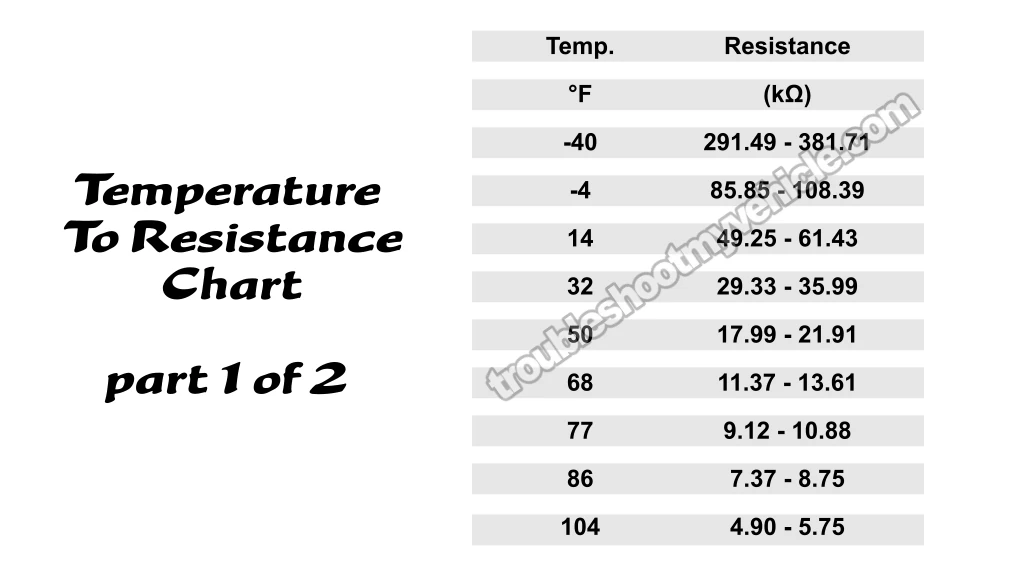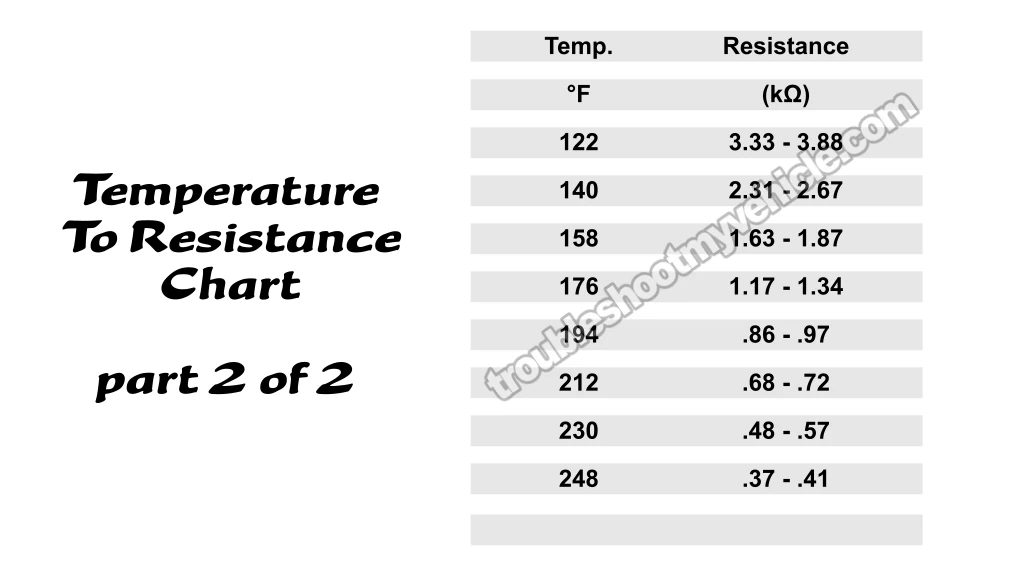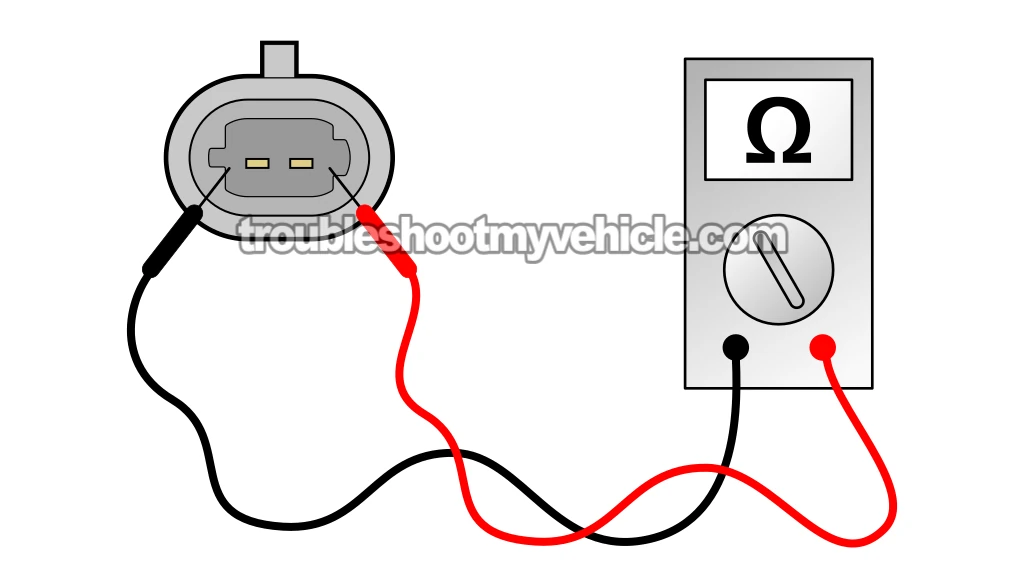
The intake air temperature (IAT) sensor is a thermistor —a resistor that changes its electrical resistance depending on the temperature.
Its job is to measure the temp of the air moving through the intake manifold and send that info to the system. It's one of the easiest sensors to test.
In this tutorial, I'm gonna show you how to test the IAT sensor with a multimeter. You'll find out fast if it's working like it should —or if it's fried and needs to be replaced.
NOTE: The intake air temp (IAT) sensor also goes by the name air charge temp (ACT) sensor.
Contents of this tutorial:
- Symptoms Of A Bad Intake Air Temperature (IAT) Sensor.
- What Does The Intake Air Temperature (IAT) Sensor Do?
- Common Intake Air Temperature (IAT) Sensor Problems.
- Initial Checks Before Starting The IAT Sensor Tests.
- Where To Buy The IAT Sensor And Connector.
- Checking Temperature To Resistance Value Relationship.
- More 5.2L, 5.9L Dodge Ram Van Tutorials.
APPLIES TO: This tutorial applies to the following vehicles:
- 1992-1994:
- Dodge Ram B150 Van 5.2L V8: 1992, 1993, 1994.
- Dodge Ram B250 Van 5.2L V8: 1992, 1993, 1994.
- Dodge Ram B250 Van 5.9L V8: 1992, 1993, 1994.
- Dodge Ram B350 Van 5.9L V8: 1992, 1993, 1994.
- 1995-1997:
- Dodge Ram B1500 Van 5.2L V8: 1995, 1996, 1997.
- Dodge Ram B2500 Van 5.2L V8: 1995, 1996, 1997.
- Dodge Ram B3500 Van 5.2L V8: 1995, 1996, 1997.
- Dodge Ram B2500 Van 5.9L V8: 1995, 1996, 1997.
- Dodge Ram B3500 Van 5.9L V8: 1995, 1996, 1997.
OTHER IAT SENSOR TESTS:
- Throttle Body Temp Sensor Tests (1989-1991 5.2L, 5.9L V8 Dodge Ram Van).
- How To Test The Intake Air Temp (IAT) Sensor (1998-2003 5.2L, 5.9L V8 Dodge Ram Van).
Symptoms Of A Bad Intake Air Temperature (IAT) Sensor
Your V8 Dodge Ram van runs on a speed-density fuel injection system. In this setup, the fuel injection computer uses three main inputs to figure out how much air's getting into the engine, so it can deliver the right amount of fuel:
- Engine RPM comes from the crankshaft position (CKP) sensor.
- Vacuum pressure in the intake manifold is read by the manifold absolute pressure (MAP) sensor.
- Air temperature flowing in the intake manifold picked up by the intake air temperature (IAT) sensor.
Since the IAT sensor feeds crucial info for fuel delivery calculations, when it fails, the PCM logs a trouble code and the check engine light (CEL) pops on. You'll see one of these:
- OBD-I (1993–1995):
- Code 24: Charge Air Temp Sensor Voltage High or Low.
- OBD-II (1996–1997):
- P0112: Intake Air Temperature (IAT) Sensor Voltage Low.
- P0113: Intake Air Temperature (IAT) Sensor Voltage High.
When the IAT sensor goes bad, you'll usually get a trouble code —but it can also cause other problems, like:
- Hard start: In hot or cold weather, the engine can take longer to fire up.
- Low power: Acceleration feels slower and the engine might feel "lazy".
- Rough idle: The engine can shake or run uneven while sitting at a red light.
- Engine stalling: The engine just quits on you all of a sudden.
- Engine no-start: Sometimes, the engine won't start at all.
- Bad gas mileage: This happens because the PCM is dumping too much fuel, killing your gas mileage.
What Does The Intake Air Temperature (IAT) Sensor Do?
The intake air temperature (IAT) sensor reads the temp of the air going into the engine and sends that info straight to the fuel injection computer.
It works as a thermistor, which means its resistance changes with temperature. The sensor gets a 5-Volt reference signal from the fuel injection computer, and that voltage drops based on the sensor's resistance at the moment.
The computer watches that voltage drop and uses built-in calibration data to figure out the actual air temperature.
Accurate readings from the IAT sensor are key for proper fuel delivery, ignition timing adjustments, and smooth engine performance.
Common Intake Air Temperature (IAT) Sensor Problems
A few common problems can knock out the IAT sensor.
- Old age: Like other parts, the sensor just wears out after a while and stops doing its job.
- Internal open-circuit: A break inside the sensor's circuit kills the signal and it stops working.
- Internal short-circuit: A short inside the sensor messes up the signal or shuts it down completely.
- Damaged wire insulation: If the wires' insulation cracks or dries out, they can touch and short each other out.
- Connector damage: The most common issue is the sensor's connector locking tab breaks —usually when you unplug it. That ends up causing an intermittent false connection to the PCM.
Any of these issues make the sensor feed bad info to the powertrain control module (PCM), which can throw off engine performance and light up the check engine light with an IAT sensor trouble code (DTC).
Initial Checks Before Starting The IAT Sensor Tests
Before resistance testing the IAT sensor with your multimeter, take a minute to do these quick visual checks:
- Check the sensor's wires for any obvious damage —look for cuts, frays, or exposed strands.
- Inspect the connector for damage, especially if the locking tab is broken or missing.
- Take a close look at the sensor itself. The top is plastic and can snap off from the metal base if it's been manhandled in the past.
Fraying happens when the insulation around the wires wears down and exposes the metal underneath. It's a common issue with IAT sensor connector and its two wires.
Once the wires are exposed, they can short out. That causes false temperature readings and triggers the check engine light.
Here's a real-world example of what that kind of damage looks like:
- IAT Sensor Wire Insulation Problem And Wires Shorted Together (source: easyautodiagnostics.com).
You've got two options to deal with this:
- If the fraying is heavy or right near the connector, you've go to swap out the entire connector with a new one.
- If the damage is light and farther down the wire, wrapping it with electrical tape can hold you over for a bit.
NOTE: Electrical tape is a temporary fix. For a solid, long-term fix, go ahead and replace the damaged wiring or connector.
Where To Buy The IAT Sensor And Connector
Disclosure: As an Amazon Associate, I earn from qualifying purchases. If my tutorials help you, using these links is an easy way to support the site at no extra cost to you. Thank you!
Checking Temperature To Resistance Value Relationship
Like I said earlier, the IAT sensor's resistance changes as the air in the intake manifold heats up or cools down. Each resistance value matches up with a specific air temperature.
If the sensor's working right, it'll give you a reading within about 10 degrees (plus or minus) of the actual outside temp in your area.
If the sensor's bad, here's what you'll usually see when you test it with a multimeter:
- Open-circuit: The multimeter shows "OL" (infinite resistance), which means there's no continuity through the sensor.
- Short-circuit: The multimeter reads "0 Ohms", showing that the circuit is completely shorted.
IMPORTANT: For this resistance test to be accurate, the sensor needs to be cold. If the engine's been running, give it time to cool down all the way before you start.
Alright, here's what to do:
- 1
Check the current outside temperature where you are.
Open the weather app on your phone or use a wall thermometer to get a reliable reading. - 2
Locate the IAT sensor and unplug it from the harness.
LOCATION: You'll find the IAT sensor near the front of the intake manifold on the passenger side of the engine. Check photo 4 in the image viewer above. - 3
OPTIONAL: Carefully remove the sensor from its spot on the intake manifold.
NOTE: You can test the IAT sensor while it's still mounted. But if it's easier for you, go ahead and take it out. - 4
Set your multimeter to Ohms (Ω) mode.
- 5
Measure the sensor's resistance by touching the multimeter leads to the sensor's two male terminals.
- 6
Write down the resistance reading from the multimeter.
- 7
Compare your reading with the values on the Temperature-To-Resistance Chart (check the chart in the image viewer above).
The number should match your current air temp, give or take 10°F.
Now, let's figure out what your results mean:
CASE 1: The resistance doesn't match the expected range for the current temp. That means the IAT sensor's bad. Replace it.
CASE 2: The resistance matches what it should for your temp. That means your IAT sensor is doing its job.
More 5.2L, 5.9L Dodge Ram Van Tutorials
You can find a complete list of tutorials for the 5.2L/5.9L V8 Dodge Ram Van in this index:
Here's a sample of the tutorials you'll find in the index:
- How To Test The MAP Sensor (1992-1997 5.2L, 5.9L V8 Dodge Ram Van).
- How To Test The Intake Air Temp (IAT) Sensor (1992-1997 5.2L, 5.9L V8 Dodge Ram Van).
- How To Test The TPS (1992-1997 5.2L, 5.9L V8 Dodge Ram Van).
- How To Test For A Blown Head Gasket (1989-2003 5.2L, 5.9L V8 Dodge Ram Van).

If this info saved the day, buy me a beer!








